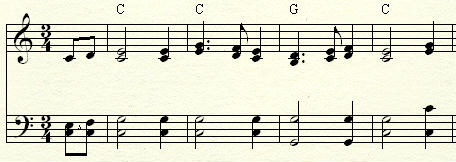Free Lessons
Two ways to add 7ths to your music
Don’t read this unless you have read and understand this lesson: http://www.greghowlett.com/blog/free-lessons/sevenths.aspx
If you do understand that lesson, you know the difference between a major and minor 7th and you know which 7th needs to be added to chords based on the chord’s number. (I and IV chords typically get major 7ths and all other chords get minor 7ths.)
Now, how do you actually start adding the 7ths to your music. I am going to give you some tips for do this if you are just playing simple block-style chords, which by the way is a great way to play.
Before I start, let me introduce a new concept called voicing. I have run across many a college music major who does not even know what voicing is. That is a shame because it is a very important thing to understand. Voicing refers to the way the notes in a chord are ordered and spaced. For example, here are some C chords, but they are voiced differently.

Good voicing is critical to getting a good sound. A great chord with bad voicing sounds horrible. A simple chord with great voicing sounds divine.
So here is why I am introducing voicing before discussing how to add 7ths. If you are going to add 7ths in ways that sound good, you have to voice them right. Voicing is very complicated and I cannot go into too much detail here, but I do have a few simple voicing rules related to adding 7ths that will dramatically help you.
First, understand that you are safest adding the 7ths somewhere in the middle of the chord as it is played on the piano. It will not sound good too close to the root unless the root is played high, and it will often clash with the top note if you play it too close.
If you understand that, you will understand why I would suggest you try to play the 7th with the thumb of either hand. This of course is not a hard fast rule, but it works because your thumbs will obviously naturally be in the middle of the voicing.
If you are a typical church pianist, your thumb is doubling another note anyway. Check yourself and see if I am not right. The right thumb often doubles the melody note and the left thumb often doubles the bass note. That is the way many of us were taught to play.
Let’s take a few examples from the first few measures of “Just As I Am”. In a hymnal, you will probably see something that looks like this.

Now, from the previous lesson, you should be able to figure out which 7ths to add to each chord. The C chord should get a major 7th (B natural) and the G chord should get a minor 7th (F natural). Assuming you are going to play the song in the same style as written, let’s use the thumb suggestion to add 7ths.
Measure 1 needs a B natural. Note that the right thumb is currently doubling the bass. Just slide the thumb down to the B. Play the chord both ways on the piano and note how big an improvement that makes. You can do the same thing to measure 4.
In measure 2, the thumb is not playing anything as written. If you like the sound, try playing a B with the thumb there as well. (You might decide that all three of those C chords should not get a major 7th, and if you did, I would probably agree with you. You can overdo a good thing.)
In measure 3, the thumb on the left hand is doubling the root. That is a waste. Instead, slide the thumb down and play the 7th instead (F).
Here is are the four bars again with the changes. (Note I have made a few other changes to help the sound. You do not need to worry about them at the moment, but I wanted to keep the sound of the major 7ths a bit more subtle.)

So here is the takeaway. Pick any song out of your hymnal and you will see that there are numerous opportunities to add the 7th using just this little tip involving your thumbs. Stop wasting your thumbs by doubling other notes and put them to more useful work.
